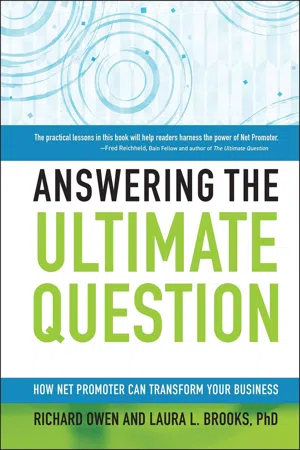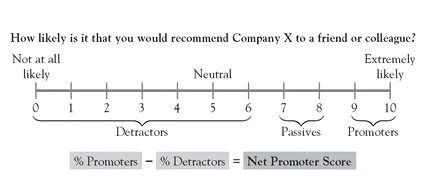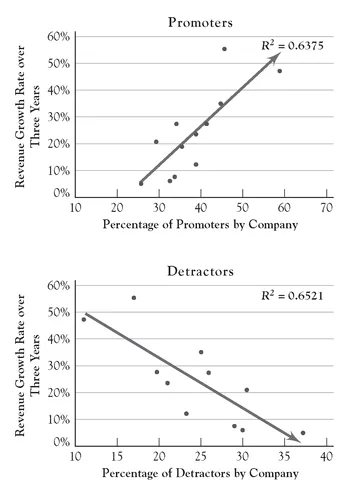![]()
1
Net Promoter Fundamentals and Operating Model
We have driven, since early 2000, the notion that to be customer centered is a very important part of the value system of our company and we have to keep that ever present in our minds.
John W. Thompson, chairman and CEO, Symantec
This chapter lays out the basic elements of the Net Promoter Operating Model and sets the context for much of the rest of the book. You may think this is an obvious task, but when posed with the question, “What is Net Promoter?” we found that beyond the metric, no consensus seemed to exist. We start with the metric, summarizing the underlying concepts that support it, and draw a distinction between it and more traditional approaches. Finally, we propose a model to build a Net Promoter program and drive a customer-centric culture.
A Net Promoter Primer
Is Net Promoter a metric or a way of doing business? The answer is “both.” Net Promoter is a discipline that has progressed well beyond the computation and into a series of best practices that drive positive financial results for the organizations that adopt it. This chapter goes beyond the simple mathematics required to calculate the metric and into the discipline that makes Net Promoter work. Applying Net Promoter as a management discipline separates successful programs from those that fail. However, before we elaborate, let’s review Net Promoter the metric.
Net Promoter is the most progressive methodology in loyalty measurement. When people refer to “the Net Promoter question” or “the Recommend question,” they are referring to the ultimate question from Fred Reichheld’s book of that title: How likely is it that you would recommend Company X to a friend or colleague? The response to this question has proven to be an effective means for measuring customer loyalty and ultimately long-term growth.
In order to calculate the Net Promoter Score (NPS), the Recommend question should be asked using a scale from 0 to 10, in which 10 is extremely likely and 0 is not at all likely. The calculation then takes the percentage of respondents that select a rating of 9 or 10 minus the percentage of respondents that select a rating of 0 through 6 (see Figure 1.1).
NPS captures two key behaviors: buyer economics (the value of the customer) and referral economics (their potential value through referral). The first deals with an individual’s own choices and the second with how those choices influence others. The difference—the net—is the metric of interest. It takes into account the positive impact of Promoters (higher repurchase rates and referrals) and the negative impact of Detractors (negative comments, lower repurchase rates) to yield a summary metric. This is particularly critical in today’s connected world, where word of mouth can spread more quickly and positive or negative sentiments can remain on the Internet for a long time.
Figure 1.1 Calculating the Net Promoter Score
NPS’s compelling benefit lies in its ability to capture the net effect of customers who promote over customers who detract. By taking into account the increased growth achieved through positive buyer purchase and referral economic behavior, as well as the impediment to growth caused by the effects of reduced customer purchase and negative referral behavior, NPS provides an accurate assessment of customer loyalty and its impact on growth.
The payoff for a company with an improving NPS is reduced customer churn, decreased cost to serve, increased lifetime value, and improved cross- and up-sell opportunities. NPS also reflects the reality of word of mouth since Promoters provide positive word of mouth, and Detractors engage in negative word of mouth about the company and its products or services.
Some have argued that Detractors don’t matter—that they don’t actually have a negative impact on a business. Based on three years of data comparing NPS and publicly disclosed financial results, it is clear that there is a direct correlation between increased scores and increased revenue growth. Similarly, higher percentages of Detractors also link to reduced growth rates (see Figure 1.2). This evidence shows that it is not just Promoters but the absence of Detractors that create a positive growth engine.
Why Traditional Approaches Fail
Successful Net Promoter programs are not traditional customer satisfaction programs with the Recommend question added for convenience. Before Net Promoter, many customer satisfaction programs yielded management reports that lacked credibility. Perhaps more important, they didn’t deliver business results. Before we lay out what makes an effective program, it’s worth considering the contrast with prior approaches. We have boiled this down to the distinction between research studies and operational programs.
Figure 1.2 Revenue Growth Rates by Promoters and Detractors
Source: Satmetrix client data. Average international NPS from 2002-2004 (N = 12, n = 80,000); public financial data 2003-2005 or 2004-2006 depending on fiscal year.
An Operational Approach, Not a Research Project
Research-based approaches to customer satisfaction have not been tremendously successful in terms of improving satisfaction. Customer satisfaction scores for the majority of large corporations have not historically shown significant improvement. Although annual reports highlight the importance of customers (usually accompanied by glossy photos and glowing tributes), many CEOs, when interviewed, have expressed a lack of confidence in their customer satisfaction efforts or a disregard for the programs that exist. Billions of dollars a year are spent on customer satisfaction surveys and market research, and outcomes seldom seem to result in any real changes to the business. Consider your own experiences as a consumer. When you fill in a customer satisfaction survey, do you believe that something will happen as a result?
Research can be valuable for the organization, but viewing your investment in customer loyalty as a research project is setting your efforts up for failure. We unfortunately continue to witness the stereotypical annual customer satisfaction report, presented to a suspicious executive team that invests just enough time to argue its validity before consigning it to the corporate bookshelf for another year. This is the classic outcome of a program that is driven from the needs of research rather than the needs of the business.
By contrast, an operational approach starts by understanding which customer data and internal processes will create change across the organization and how to use that information effectively. Whereas a research approach focuses on creating an insightful report for a handful of executives, an operational approach is concerned with building a program that engages the entire organization in improving customer relationships. Your operational program quickly becomes part of the ongoing management processes and touches line employees in their everyday jobs.
Creating a new research project that simply uses and measures NPS won’t change your business; no miracle will occur simply from adding the Recommend question. Instead, success will come from grounding your program in an operational approach and applying Net Promoter principles one customer at a time.
Satisfaction Versus Loyalty
It’s worth clarifying the difference between satisfaction and loyalty. Simply put, satisfied customers still defect. The fact is that satisfaction is a standard that had great meaning in the postwar industrial growth of Europe and the United States but falls short against the standards of global hypercompetition today. Worse, it provides a false standard that undermines the impact that leadership could obtain by applying a higher standard to their businesses.
If you turn on your TV and see a company claiming to have 90 percent customer satisfaction, what does it tell you? It certainly indicates that the company’s basic products or services seem to work as advertised. It might also suggest the company is able to handle inevitable problems in a reasonable and timely fashion. You might even suppose that this business’ help desk phones are not clogged with customers calling in to complain about the company. But does any of this sound like a basis for competitive advantage or an engine for growth?
Net Promoter programs establish a higher standard than simple satisfaction, one worth holding your business to. There is no false sense of comfort, just a real focus on the drivers of growth and competitive advantage.
Dell, the world’s largest direct-sale computer manufacturer, runs a global customer experience program and understands the distinction between satisfaction and true loyalty. Dick Hunter, who heads the global consumer support program, told us:
The thing I was struck by is that we were all hung up about customer satisfaction, and I frankly didn’t think that was the right goal. It’s one thing to have a customer call us with a problem. We solve their problem, and they’re satisfied with the fact that we solved the problem. It’s an entirely different matter if, after a customer calls us, they’re much more loyal to us and say, “I’m going to buy from Dell forever because I really get great service and that’s part of the overall experience that is great and I couldn’t imagine buying from anybody else.” There’s a huge difference between those two. And my view was that we had to go toward loyalty and move away from satisfaction.
We couldn’t agree more.
Loyalty Metrics Held to the Standards of Financial Reporting
If you have heard Fred Reichheld speak, you may have heard him refer to his goal of having the NPS achieve the same standards of rigor and “auditability” as accounting based on Generally Accepted Accounting Principles. Most companies take financial reporting seriously. They hire outside auditors to confirm that their representations of the facts are accurate. Standards exist and evolve to meet the needs of current business practices. The repercussions of misrepresenting the numbers can be very serious under law, including jail time.
Another way to look at financial reporting is to understand that the most important output of good reporting is quality data given to management on which they can base important decisions with confidence. In other words, this is information for running the business. In the same way, a Net Promoter program should provide quality customer data that enables strategic decision making.
Now picture the way most companies review customer satisfaction data and imagine for a minute using the same method for reviewing financial information. Board meetings would consist of lengthy sessions where the accounting team seek to explain the meaning of the organization’s performance in statistical terms that only they could understand. Executives would debate the validity of the numbers. There would be a refusal to take action because the board relentlessly questions whether those are “real numbers” or even “realistic scenarios.” Department heads would claim to understand the true picture around actual and projected revenue without this and would argue they don’t need accounting telling them what they already know about their business. Why spend money on this kind of data anyway?
This scenario is a bit absurd, yet it’s exactly what happens with customer data when it fails to achieve a standard we reserve for critical information about our business. Net Promoter differs from traditional satisfaction metrics in that it focuses on customer data as an instrument for general business management, not just customer research, and because it is simple for everyone to understand and is actionable by employees. Moreover, the emphasis on obtaining high response rates, census approaches in business-to-business markets, antigaming focus, and methodical goal setting are all part of what makes the Net Promoter approach more trustworthy. Boards and management can use Net Promoter data just as they do financial data to make decisions that grow the company.
Bad Profits
The concept of bad profits is critical to Net Promoter. We were recently challenged by an executive to explain why the term bad profits is not an oxymoron in the business world. Well, that’s exactly the problem many companies face. The simplest way of looking at bad profits is to consider them profits that come at the expense of long-term growth because of the Net Promoter penalty they incur. They are short-term profit and cost friendly, but long-term customer and profit unfriendly.
There does seem to be a lot of confusion around this issue, so we illustrate it with our favorite example of a CEO who understands the difference, Rupert Soames from Aggreko. He nailed it for us:
The disadvantage of financial reporting is that it is a lagging indicator, not a leading indicator, and the lag can often be quite long and quite severe. Managers are confronted daily with the opportunity to make more profit in the short term and give poor customer service at the expense of irritating their customers in the long term. What I have always been looking for is a way of squaring the circle that will enable us to say to employees, “Yes, you are to make as much profit as you can, but in so doing, we want to judge your operational effectiveness in terms of the way you’re delivering service.”
The first of the month, we map NPS to revenues and costs, and we can quickly relate financial performance to operational excellence and to delivering new customer service.
Tackling bad profits does not, in our opinion, mean that you are in business to be altruistic. Nor does it mean that every customer has a vote on what should be good or bad profits. Many customers have their own ideas that may not be right for your business. You might personally think that it’s outrageous that your public relations agency charges you a rush fee to amend copy at the last instant, but it may fully reflect the agency’s costs and the increased value that you receive. Instead, bad profits often rely on some form of trap—a business process that is perfectly legal but clearly designed to charge abnormal profits to take advantage of a customer in the short term. The vast majority of customers would recognize this behavior as being bad profits and penalize the organization with lost future business.
Companies that believe in Net Promoter are sensitive to the issue of bad profits and actively find ways, as in the Aggreko case, to safeguard against these types of business practices. It’s often the case that root cause analysis of Net Promoter results will point directly to the underlying source of those bad profits and present a clear business choice of current versus future costs.
Net Promoter: Key Tenets
A successful Net Promoter program includes several factors that work together. Although NPS is useful, the most prevalent cause of failure in Net Promoter programs is the inability of the organizati...


